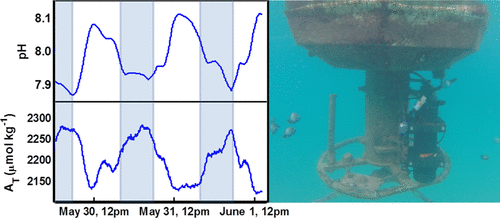当前位置:
X-MOL 学术
›
ACS Earth Space Chem.
›
论文详情
Our official English website, www.x-mol.net, welcomes your
feedback! (Note: you will need to create a separate account there.)
Autonomous Ion-Sensitive Field Effect Transistor-Based Total Alkalinity and pH Measurements on a Barrier Reef of Ka̅ne’ohe Bay
ACS Earth and Space Chemistry ( IF 2.9 ) Pub Date : 2020-02-21 , DOI: 10.1021/acsearthspacechem.9b00274 Ellen M. Briggs 1 , Eric Heinen De Carlo 2 , Christopher L. Sabine 2 , Noah M. Howins 2 , Todd R. Martz 1
ACS Earth and Space Chemistry ( IF 2.9 ) Pub Date : 2020-02-21 , DOI: 10.1021/acsearthspacechem.9b00274 Ellen M. Briggs 1 , Eric Heinen De Carlo 2 , Christopher L. Sabine 2 , Noah M. Howins 2 , Todd R. Martz 1
Affiliation

|
Here, we present first of its kind high-frequency total alkalinity (AT) and pH data from a single solid-state autonomous sensor collected during a six-day deployment at a barrier reef in Ka̅ne’ohe Bay on the CRIMP-2 buoy. This dual parameter sensor is capable of rapid (<60 s), near-simultaneous measurement of the preferred seawater carbonate system parameters, pH, and AT without requiring any external reagents or moving parts inherent to the sensor. Its solid-state construction, low power consumption, and low titrated volume (nanoliters) requirement make this sensor ideal for in situ monitoring of the aqueous carbon dioxide system. Through signal-averaging, we estimate the pH–AT sensor is capable of achieving 2–10 μmol kg–1 precision in AT and 0.005 for pH. The CRIMP-2 site in Hawai’i provided an excellent means of validation of the prototype pH–AT sensor because of extensive observations routinely collected at this site and large daily fluctuations in AT (∼116 μmol kg–1) driven primarily by high calcification during the day and occasional CaCO3 mineral dissolution at night. High-frequency sampling by the pH–AT sensor reveals details in the diurnal cycle that are nearly impossible to observe by discrete sampling. Greater temporal resolution of the aqueous carbon dioxide system is essential for differentiating various drivers of coral reef health and the response to external influences such as ocean warming and acidification.
中文翻译:

Ka̅neohe湾障壁上基于离子敏感场效应晶体管的总碱度和pH测量
在这里,我们展示了在CRIMP-2浮标在Ka̅ne'hehe湾的堡礁六天部署期间从单个固态自主传感器采集的单个固态自主传感器的高频总碱度(A T)和pH数据。这种双参数传感器能够快速(<60 s)几乎同时测量首选的碳酸盐海水系统参数,pH和A T,而无需传感器本身具有任何外部试剂或移动部件。它的固态结构,低功耗和低滴定体积(纳升)要求使该传感器成为现场监测含水二氧化碳系统的理想选择。通过信号平均,我们估计pH – A T该传感器能够在A T中达到2–10μmolkg –1的精度,而在pH方面则达到0.005。夏威夷的CRIMP-2站点提供了一种验证原型pH– A T传感器的极好方法,因为在该站点上例行的广泛观察以及主要由驱动的A T(〜116μmolkg –1)的每日大波动白天钙化程度高,夜间CaCO 3矿物质偶尔溶解。通过pH – A T进行高频采样传感器揭示了昼夜循环中几乎不可能通过离散采样观察到的细节。水性二氧化碳系统的更高时间分辨率对于区分珊瑚礁健康的各种驱动因素以及对诸如海洋变暖和酸化等外部影响的响应至关重要。
更新日期:2020-02-21
中文翻译:

Ka̅neohe湾障壁上基于离子敏感场效应晶体管的总碱度和pH测量
在这里,我们展示了在CRIMP-2浮标在Ka̅ne'hehe湾的堡礁六天部署期间从单个固态自主传感器采集的单个固态自主传感器的高频总碱度(A T)和pH数据。这种双参数传感器能够快速(<60 s)几乎同时测量首选的碳酸盐海水系统参数,pH和A T,而无需传感器本身具有任何外部试剂或移动部件。它的固态结构,低功耗和低滴定体积(纳升)要求使该传感器成为现场监测含水二氧化碳系统的理想选择。通过信号平均,我们估计pH – A T该传感器能够在A T中达到2–10μmolkg –1的精度,而在pH方面则达到0.005。夏威夷的CRIMP-2站点提供了一种验证原型pH– A T传感器的极好方法,因为在该站点上例行的广泛观察以及主要由驱动的A T(〜116μmolkg –1)的每日大波动白天钙化程度高,夜间CaCO 3矿物质偶尔溶解。通过pH – A T进行高频采样传感器揭示了昼夜循环中几乎不可能通过离散采样观察到的细节。水性二氧化碳系统的更高时间分辨率对于区分珊瑚礁健康的各种驱动因素以及对诸如海洋变暖和酸化等外部影响的响应至关重要。











































 京公网安备 11010802027423号
京公网安备 11010802027423号